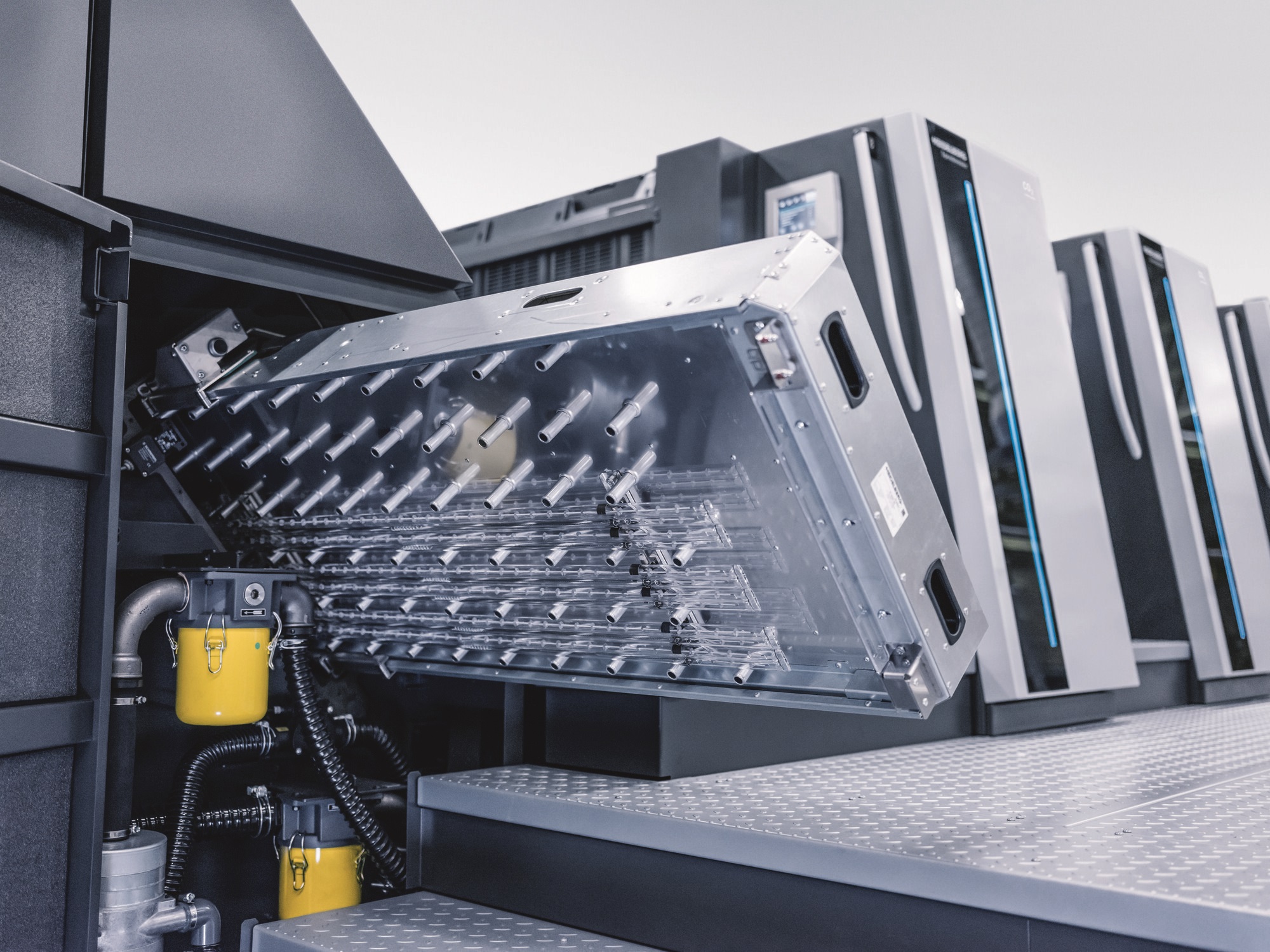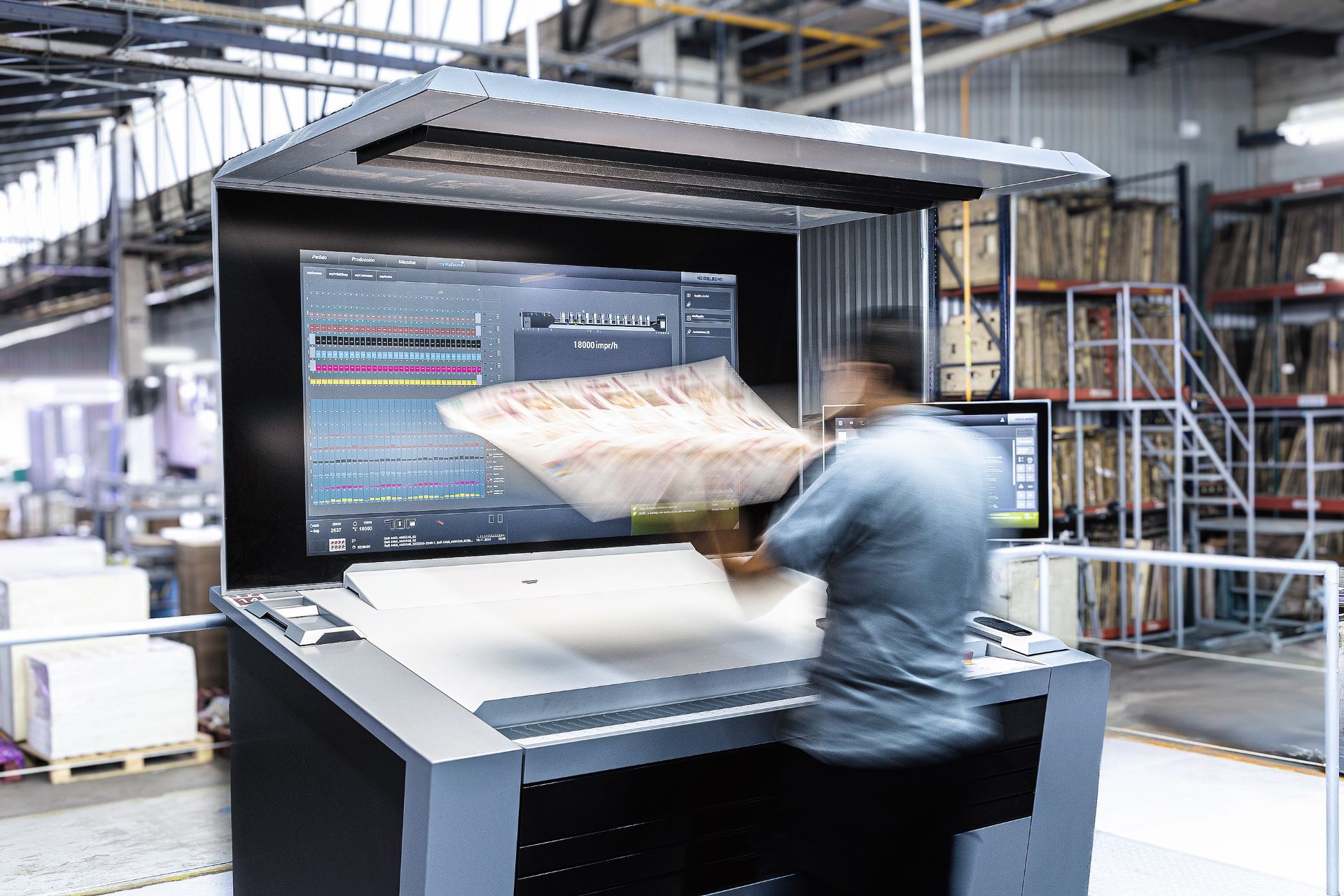The Speedmaster XL 106-6+L starts to print. The sheetfed offset press quickly ramps up to its top speed of 21,000 sheets per hour. An integrated measuring device indicates the energy consumption per 1,000 sheets, which is ultimately just 8.1 kilowatt-hours. As soon as the job is complete and there are no further orders in the queue, the state-of-the-art printing system switches to standby mode.
This is the ideal scenario – reaching full capacity fast and switching to standby quickly. After all, energy efficiency increases along with speed, and using standby mode for just one hour each day saves a print shop 3,600 kilowatthours per year. Being able to switch off components and start up the press again quickly is the key – an advantage offered by HEIDELBERG.


DryStar Combination Eco saves up to 30 percent energy through optimized energy input, integrated heat recovery, and thermal insulation.


Prinect Inpress Control actively contributes to conserving resources. Automated color and register control without sheet removal significantly reduces waste and makeready times.
Compared to conventional systems, the DryStar Combination Eco saves 30 percent of the energy required for drying: it recovers heat generated by various components. This is because a reflector reflects the infrared rays back onto the sheet, thereby improving drying. It is also because the nozzles require less warm air to achieve the same effect. And because the dryer is well insulated. All of this saves energy and pays off for the customer.
Prinect Inpress Control is another feature worth highlighting. As soon as a job is running, the integrated measuring system based on the prepress stage adjusts the color fully automatically, checks it, and makes any necessary adjustments. Stopping the machine, pulling out sheets, and checking the color is now a thing of the past. With Prinect Inpress Control, printers save setup time and reduce waste. Productivity increases while resource consumption decreases.
"If you want to make technologies sustainable for the future, you have to look at the entire system and optimize it," says Harald Woerner.
These product-related measures are part and parcel of the HEIDELBERG sustainability strategy. The ESG criteria, which cover environmental and social responsibility and corporate governance, act as a guideline. By documenting progress in these areas on an annual basis, HEIDELBERG is complying with the European Union’s Corporate Sustainability Reporting Directive (CSRD).
The starting point for the current requirements was the 2015 Paris Agreement. The European “Green Deal” in 2019 took things a step further. As Head of Corporate Sustainability Dr. Eva Boll explains, something became clear to HEIDELBERG back then: “The need for a broader, more strategic approach.” The resulting strategy was launched in 2021 and is continuously evolving. Boll is now in charge of a dedicated team and reports directly to the Management Board. The long-term goal is to reduce emissions throughout the value chain to net zero by 2051.
HEIDELBERG is currently focusing on Scope 3, as this accounts for 97 percent of emissions. It covers greenhouse gas emissions associated with the company’s presses both upstream and downstream of their actual production. The emissions generated when machines are operating in print shops account for over half the total. HEIDELBERG and its customers therefore benefit from any machine feature that results in a smaller carbon footprint.
Purchased goods and services are the second largest contributor to emissions. That makes it worth checking the feasibility of using recycled materials in production. The purchasing and development teams need to collaborate closely on this. “We won’t see results overnight, but we are tackling the issue,” says Boll. The objectives are to prevent wastage, facilitate reuse, and create recycling loops. Logistics also has a role to play.
Small measures all add up and have an impact. “For example, a truck heading from our foundry in Amstetten to Wiesloch just under 200 kilometers (125 miles) away now stops off at a supplier to ensure it doesn’t make the trip only half full,” explains Boll. At the international level, too, HEIDELBERG is in dialog with logistics companies with a view to operating as responsibly as possible.
At its production and development sites – which are relevant to Scopes 1 and 2 – HEIDELBERG has already been cutting greenhouse gases for a number of years. The photovoltaic systems at the Wiesloch and Amstetten sites are one example. Together, they have a maximum output of a good 8 megawatts, which saves around 2,500 metric tons of CO2 per year. In addition to this, the Qingpu site in China has been generating electricity from hydropower since 2024. Another example is the Brandenburg an der Havel plant, which has switched its production and street lighting to LED lights. To learn from others, the site’s Environmental Officer Stefan Ritzka shares information with companies in an energy-efficiency network. Sustainability only works when all the ESG elements come together.
“Companies are then resilient as they head into the future. A good attitude is vital,” emphasizes Boll. HEIDELBERG has, she says, been demonstrating the right attitude for many years in its social cooperation. “We see this in the length of time staff stay with the company, and in the way they interact and pull together - just like in a family,” she continues. This social responsibility extends beyond the factory gates. For example, the canteen at the Wiesloch-Walldorf site supplies the child protection association in Wiesloch with 3,000 free meals every year.
No machine evolves on its own, no logistics chain rethinks itself independently, and no site manages to cut its emissions out of nowhere. Only people can achieve this. HEIDELBERG is therefore increasing sustainability awareness among staff. It arranges workshops, offers apprentices the opportunity to train as energy scouts, and has an ideas portal on the company’s intranet. All this motivates the team and means potential improvements are identified. It is good for the environment, for the HEIDELBERG family, and for customers.